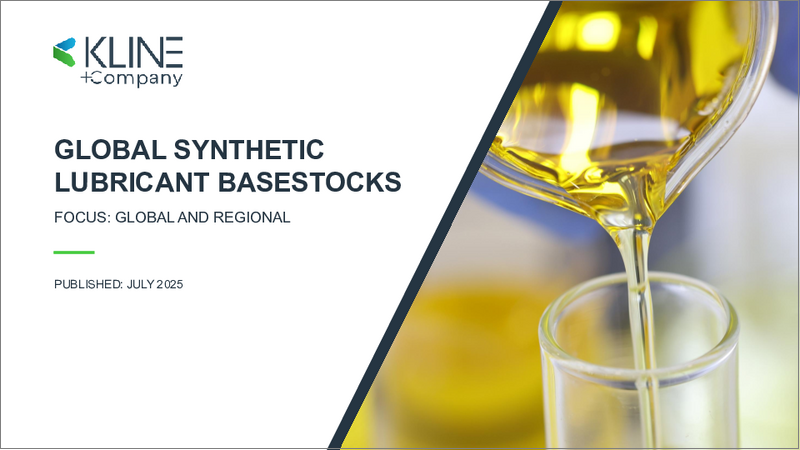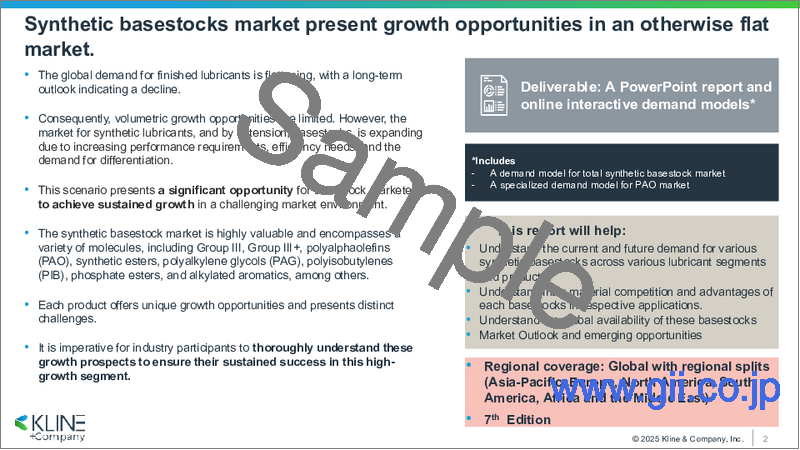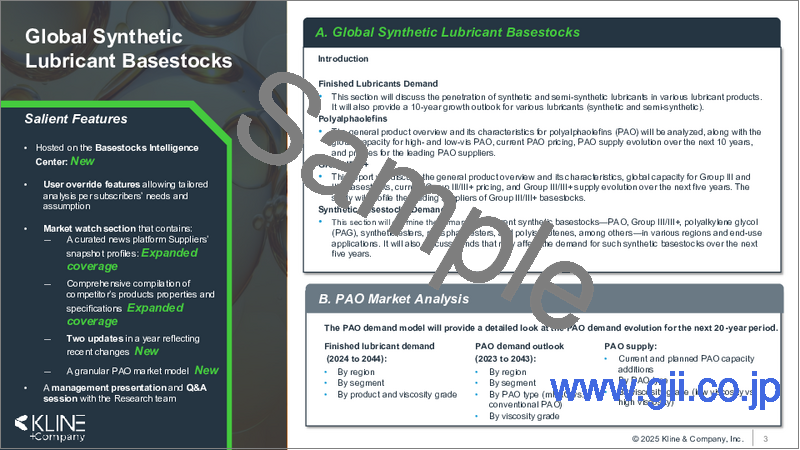|
|
市場調査レポート
商品コード
1623570
合成潤滑油ベースストックの世界市場:市場の分析と機会(2023年)Global Synthetic Lubricant Basestocks: Market Analysis and Opportunities 2023 |
||||||
|
|||||||
| 合成潤滑油ベースストックの世界市場:市場の分析と機会(2023年) |
|
出版日: 2024年07月01日
発行: Kline & Company, Inc.
ページ情報: 英文 53 Pages
納期: 即日から翌営業日
|
全表示
- 概要
- 目次
概要
持続可能な未来への移行は、合成潤滑油の使用への素早い移行を伴うため、合成ベースストックの需要が加速しています。さらに、性能要件に関する需要の高まりは、合成ベースストックの使用に有利です。
当レポートでは、世界の合成潤滑油ベースストック市場について調査分析し、各地域の合成/半合成潤滑油に関するデータや予測を提供しています。
地域範囲
|
|
目次
イントロダクション
完成潤滑油需要
ポリアルファオレフィン(PAO)
グループIII/III+
世界の合成潤滑油ベースストック市場の分析(2023年)
合成ベースストック需要
PAO需要モデルは、今後20年間のPAO需要の推移を詳細に示します。
完成潤滑油需要(2023年~2043年)
- 地域別
- セグメント別
- 製品別、粘度グレード別
PAO需要の見通し(2023年~2043年)
- 地域別
- セグメント別
- PAOタイプ別(mPAO、従来のPAO)
- 粘度グレード別
PAO供給
- 現在と計画中のPAO生産能力の追加
- PAOタイプ別
- 粘度グレード別(低粘度、高粘度)
このセクションの提供品は、Excelベースの需要モデルのみです。
目次
Product Code: Y709E
A snapshot view of the global synthetic basestocksmarket and demand evolution over the next ten years.The transition toward a sustainable future entails aswifter move toward the use of synthetic lubricants,which creates a faster demand for synthetic basestocks.Moreover, growing demand in terms of performancerequirements favors the use of synthetic basestocks.
Scope
- Global synthetic and semi-synthetic lubricant demand penetration:
- Synthetic basestock demand analysis at a global level and by key regions, covering Africa and the Middle East, Asia-Pacific, Europe, North America, and South America
- Covers synthetic basestocks such as Group III/III+, polyalphaolefin (PAO), polyalkylene glycol (PAG), synthetic ester, phosphate ester, polyisobutylene (PIB), and alkylated aromatics
- Global demand evolution of synthetic and semi-synthetic lubricants, and resultant demand for synthetic basestocks
- By segment
- By product
- By viscosity grade
Regional Coverage
|
|
Table of Contents
Introduction
Finished Lubricants Demand
- This section will discuss the penetration of synthetic and semisynthetic lubricants in various lubricant products. It will also provide a ten-year growth outlook for various lubricants (synthetic and semisynthetics).
Polyalphaolefins
- The general product overview and its characteristics for polyalphaolefins (PAO) will be analyzed, along with the global capacity for high- and low-vis PAO, current PAO pricing, PAO supply evolution over the next ten years, and profiles for the leading suppliers of PAO.
Group III/III+
- This report will discuss the general product overview and its characteristics, global capacity for Group III and III+ basestocks, current Group III/III+ pricing, and Group III/III+ supply evolution over the next five years. The study will profile the leading suppliers of Group III/III+ basestocks.
GLOBAL SYNTHETIC LUBRICANT BASESTOCKS 2023 MARKET ANALYSIS
Synthetic Basestocks Demand
- This section will examine the demand for various synthetic basestocks-PAO, Group III/III+, polyalkylene glycol (PAG), synthetic esters, phosphate esters, and polyisobutenes, among others-in various regions and end-use applications. It will also discuss various trends that may affect the demand for such synthetic basestocks over the next five years.
The PAO demand model will provide a detailed look at the PAO demand evolution for the next 20-year period.
Finished lubricant demand (2023 to 2043):
- By region
- By segment
- By Product and viscosity grades
PAO demand outlook (2023 to 2043):
- By region
- By segment
- By PAO type (mPAO vs. conventional PAO)
- By viscosity grade
PAO supply:
- Current and planned PAO capacity additions
- By PAO type
- By viscosity grades (low viscosity vs. high viscosity)






